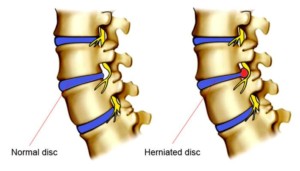Back pain affects 65 million Americans and is the sixth most costly condition in the United States. How expensive is a back surgery? Depending on the severity of your injury you may have to spend thousands on your back, and that doesn’t even count the weeks missed at work. But not all back injuries are the same. Some involve sudden sharp pain that feels like electricity shooting down your legs. Other types of back pain feel like something “came loose” and is causing you to hunch over. These two types of pain are most often related to a bulging disc or a muscular imbalance.
Bulging Disc injuries
The spine has two main components that play a role in this injury: the vertebrae and the disc that separates them. Vertebrae are hard bones and are what you can feel as your “backbone.” The disc is the cushioning material that separates them and allows you to move and bend. Injuries occur when the disc is squeezed so hard that it bulges out and presses against the nerves in that area. This can be a very small injury, and although it is measured in millimeters the pain is often so strong that it causes people to be bedridden for weeks. These injuries can heal on their own as long as they are not too severe. If your doctor performs x-rays or a MRI of your spine and determines the bulge is dangerous he or she may suggest a surgery where they cut off the bulging section of the disc.
Herniated or Slipped Disc Injuries
These injuries occur when the disc annulus is squeezed so hard that it cracks or ruptures, allowing the gel-like material to seep out into the spinal canal. Some people may not have any pain symptoms from this. But other may experience immediate pain, numbness, or tingling in the back, arms, or legs. Be sure to check with your primary care physician.
Non-Disc Related Back Pain
Some back pain can occur because of poor posture or an imbalance in your pelvis, shoulders, or even from your feet. This type of pain is more of a throbbing than a shooting pain, but it can be debilitating. Only a professional can determine if you have this type of injury, but there is good news. Unlike disc-pain injuries this type of pain can be quickly relieved through physical therapy and chiropractic adjustments. For example, your pain may be coming from an imbalance in your pelvis, causing one of your legs to be slightly shorter than the other. Over time this will cause pain, although many people do not know that it is from a shorter leg. Physical therapy for back pain can help you relieve sore and tender muscles in your back, side, and glutes. Chiropractic for back pain can help readjust your lower and upper back, helping you to feel better. Both physical therapy for back pain and chiropractic for back pain will help you learn how to stretch and build a strong posture so you can avoid this injury in the future.
